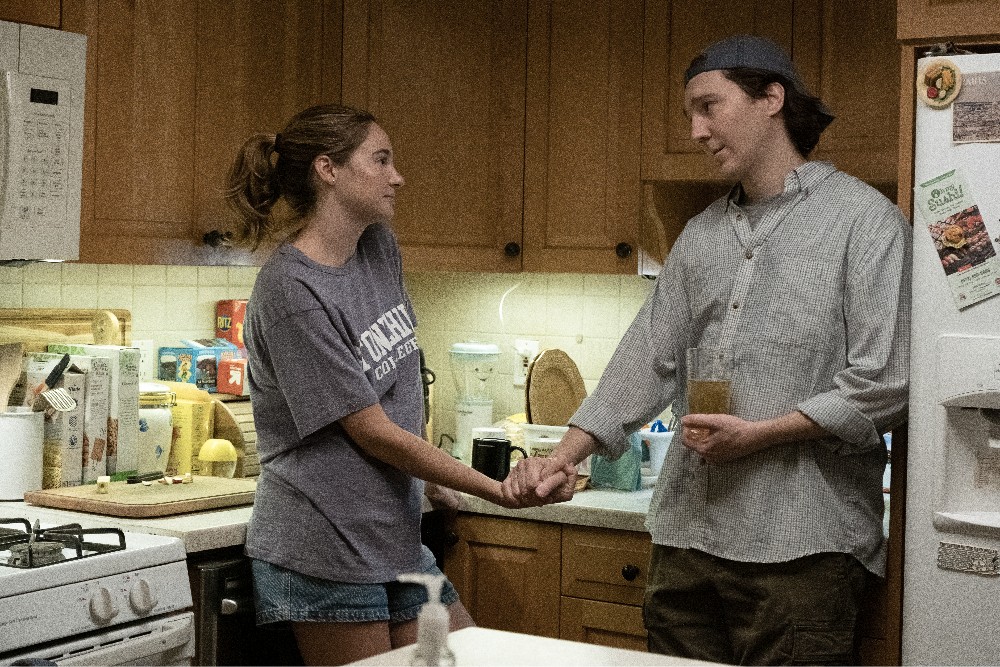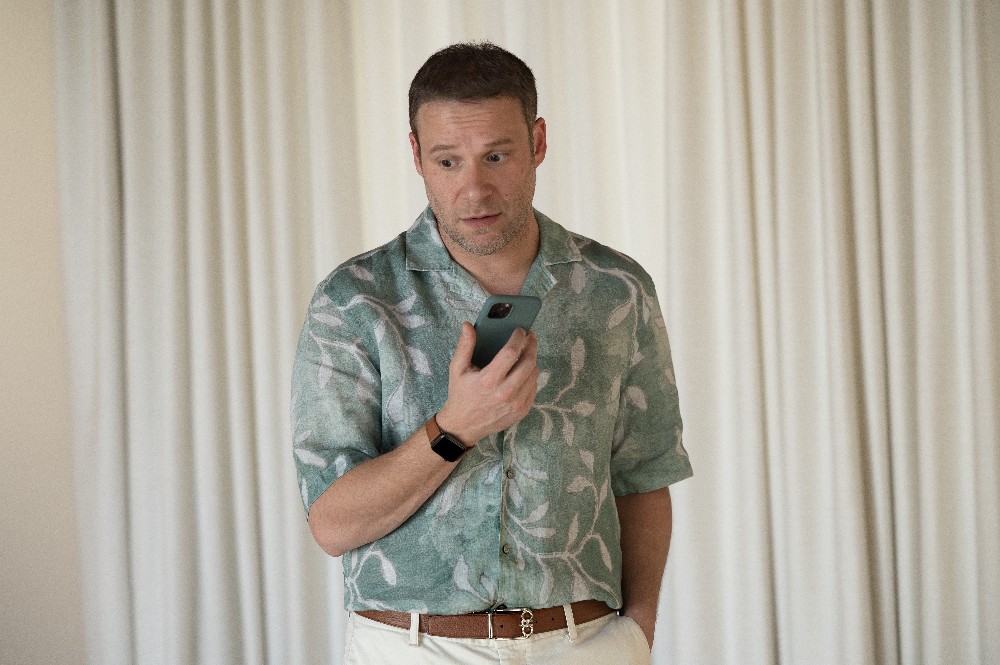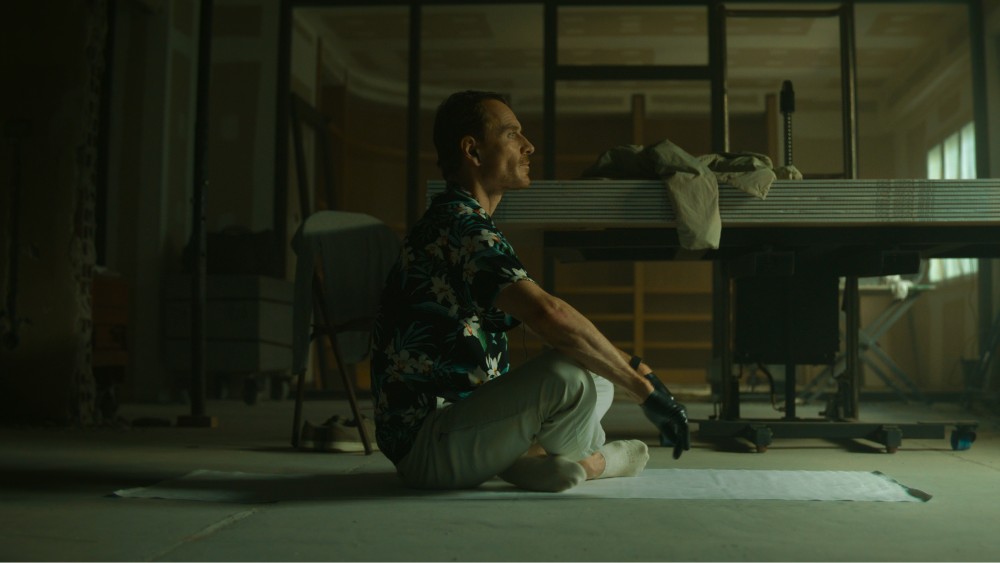
Based on Ben Mezrich‘s book, The Antisocial Network, Craig Gillespie‘s Dumb Money stars Paul Dano as Keith Gill, a financial analyst who posts videos as “Roaring Kitty,” creating a mad buying frenzy for the GameStop stock that many in the corporate hedge fund arena had been shorting. Keith’s fervor for the stock drives the stock price up as the wealthy fat cats lose millions and eventually billions.
It was a Wall Street phenom during the pandemic that had many consumers (i.e. the “dumb money’) investing in the stock exchange for the first time, many of them desperately needing the money in order to pay off college and other mounting debt.
The movie also stars Shailene Woodley as Keith’s wife, Pete Davidson as his brother Kevin, Seth Rogen, Vincent D’Onofrio, Sebastian Stan, and Nick Offerman as some of the wealthy corporate traders, and America Ferrera, Anthony Ramos, Myha’la Herrold, and Talia Ryder as some of the working class trying to make money off Gill’s financial advice.
If you’ve seen Dumb Money (or read my review) then you already know that it’s a masterclass in editing from Kirk Baxter, who has won two Oscars (in conjunction with Angus Wall) for editing David Fincher‘s The Social Network and The Girl with the Dragon Tattoo. Baxter has continued to work with Fincher on most of his recent work, including the upcoming The Killer.
Dumb Money required Baxter to assemble entire conversations between some of the players over phone calls and Zoom – this did take place during the pandemic, after all – as well as cut together various memes, while following several storylines being told concurrently. The fact that a comedy with so many things happening at once can be followed, even by those with absolutely no stock market experience, is a testament to the work Baxter did with Gillespie in editing.
Below the Line spoke with Baxter last week for this interview that allowed us to ask a few questions about working with Fincher.

Below the Line: Can you talk about getting involved with cutting this with Craig, who I assume you’d never edited with before?
Kirk Baxter: First movie I’ve cut for Craig. Craig and I are very good friends, though. Our wives are great friends. We socialize together, and we have done for years, so he’s someone very dear to me, and if he needs a hand or wants me to help out with something, I take it very seriously.
BTL: How did the discussion turn to you editing this movie, which is also based on a Ben Mezrich book, which you may have known about?
Baxter: Yeah, that came up, but really, I took the call, because Craig called me saying, “Hey, let’s meet and have dinner and a margarita.” Instead of it being a social call, he sprung on me, “I want you to cut this movie.” At the time, I was editing The Killer with Fincher. Craig’s movie started right as I was finishing The Killer, so it just sort of slid in, and I was able to help him and I was happy to do so. He’s a wonderful person, Craig, and he’s easy to work with. Very, very collaborative, extremely enthusiastic, and he’s got a sort of style.
The way we approached it is I sort of assembled it all in isolation. Like I do with all things, I’m assembling scenes, as if they’re the only things that exist, and I tend to fine-cut scenes, sort of extensively, even before I start joining them onto the rest of the movie. It’s perhaps overworking, because only later, when you start to join everything together, do you realize if you get this sort of oversight of whether it’s all required, or it can be reduced or moved, or it needs to be moved to a different place.
I lived in that minutiae of single scenes, and then when Craig would come in and watch things running together – and he was always really focused on reshuffling and moving things around and getting momentum and deviating from the law of what was written in the script. We tag-teamed in that way. As the director, Craig’s in on all things, performance and everything, but in general, I kind of sweated the details, and Craig sweated the momentum of the movie.

BTL: Did Craig tell you about this project as he was getting involved, and did he have a screenplay he could send you as he was asking you to cut it?
Baxter: He sent me a screenplay, and it was super exciting and fun. I knew a little bit about it. I think I got involved for one morning on GameStop, but I’m not much of a gambler, and I was editing — I can’t remember which movie I was editing at the time. I was having a morning coffee, and I bought in and I watched it going up, up, up, up… and I didn’t have the courage to walk away without watching it, and I had to get to work, so then I sold. I think I owned it for 25 minutes.
I knew about the topic, and I found the topic a lot of fun, and I loved the movement in the screenplay of how many different characters were all ducking and weaving together. The first act means you’ve got to meet everybody, you gotta lay all that pipe, but once you’ve done that, then all the cross-cutting gets to come in, and it can really explode into movement. That I find exciting in any film, so I was very interested based on that aspect, and all the TikTok stuff, the natural real life event of it, and Craig, from the beginning, saying that he wanted to use, not recreate it, he finds it more believable if you could use all the original things.
I knew that would be a headache in sourcing it all, and getting things approved, because that stuff tends to wriggle to the bitter end, because you can’t find this one person. But it was a challenge that I was excited by, to work with that material, as well, and the whole multimedia of it, make it all stitched together into one movie.
BTL: That’s one of the aspects that makes the film interesting is that you’re using actual memes from that time period, but you also have real members of Congress like AOC interviewing the actors, which is such a strange thing. You mentioned sourcing, so is that stuff you have to worry about much, or can you and Craig use what you need to and someone else has to worry about the licensing?
Baxter: No, there’s researching teams that have to worry about, and it certainly becomes a producer’s concern that you’re using things that can be got. I guess the only thing that I have to worry about is, do you want to live in a world of fiction, meaning are you working with material that you can’t use? Or in a world of reality, and eventually, you gotta pay the piper and work with something that can go up on the big screen?
The rhythm of this movie, both Craig and I just used whatever the hell we wanted, and assumed that everyone was going to play catch-up to it, and that’s what they did. It was a miraculous feat. There were very, very few things we had to swap out and change based on approval.
BTL: There are many scenes with just a single actor, and then it cuts to another actor, since they’re interacting over the phone or Zoom. As Craig shoots a particular actor doing their scenes and lines, are you getting that and then eventually cutting it together with scenes with other actors? Are you doing this generally as he’s shooting as well?
Baxter: Yeah, I tried to keep up with him as he shoots — I find that relaxing to try to stay with camera, and I work as fast as I can, as things are being shot, in case you unearth something that may need to be picked up. Craig shoots at such a relentless pace and can cover so many pages that I just couldn’t do it. As the shoot went on, he just got further and further in front of me, but we talked about it briefly in the beginning that mostly in regards to the basement with Paul Dano’s character, besides when his wife would join, we knew that most of the time he’s down there by himself alone, and I’ve got nowhere to go unless he’s got coverage.
I pleaded my case with him to lock down the camera and get a lot of coverage, so that I can duck and weave and dance and not be tied to a performance, that I’ve got room to wriggle out of, based on what he’s doing and looking at and not just keep returning… if I’m going to a screen to see what he’s up to, you don’t want to keep returning back to the same face or the same set-up. You want to have movement within the scene, even if the guy’s not moving himself.

BTL: Was everything on his computer monitors just green screen and added in later with visual FX and such?
Baxter: Some of it was in-screen. Some of it was thought out beforehand. It’s always helpful when that has occurred, but other times, we’ve got to recalibrate it. It’s a moving target, that kind of thing. There was a moment when it was important to Craig, that early on when we were assembling it, that we took these pauses throughout the movie. I think it was written into the script as well, to stop, fade to black, show where the stock was, and now within a timeline of what it is today, so you saw it climbing over a period of dates.
We screened it this way, and it lived like this for a couple of screenings. I remember sitting in the audience going, “I hate how the movie hits the handbrake to be hit with this data that’s analytical, and I don’t find that I care, and I don’t find that I’m tracking what it was previously, to what it is now.” Craig and I discussed it, and we were like, “Let’s rip it all out and let the characters tell us if they’re doing well, or if they’re doing bad. Their emotions are gonna let us know whether it’s a tense thing or not.” The moment we did that, the movie started to race, and it was way more enjoyable. It was more of a character piece, which was wonderful.
It was terrific that we unearthed that, because Craig’s big on screening. He likes to work for a week, screen the movie, work for a week, screen the movie, and each time we would screen it, I would panic about these things, because I wasn’t quite set. We’re booking a theater to show it on a Friday, and I’m still working on a Wednesday or Thursday, and I’m like, “I’m not ready to do this, Craig, can we push this a week?” And he’s like, “Come on, it’ll be fine.” He is a bit like a speeding train, but we always learn from every one of those screenings. They always educated us on what the movie wanted to do. It spoke back to us. As much as it was a relentless way to put a movie together, it was an effective way.
BTL: There’s that famous saying about making movies three times: once when you write it, once while you’re shooting, and once in the edit and post. How closely is Craig sticking to what was written in the screenplay once he gets to the edit, especially considering how it’s cutting between the different characters and storylines?
Baxter: Rebecca [Angelo] and Lauren [Schuker Blum] wrote a really great screenplay, but I don’t think Craig feels that… he’s happy to throw anything out to make something better. We certainly played around with order. We only dropped two or three scenes, pretty small things, but it was always about momentum. We absolutely hacked into scenes, and usually, it was if somebody’s doing a lot of explaining. Those got a bit tiresome to listen to – I call them the “Scooby Doo scenes.” [laughs] They would just bog down as people are trying to catch up with lingo and things like that.
There’s a close friend of ours that watched it and went, “Oh my god, the movie is making me feel stupid, like I can’t keep up with it.” I think that had a lot to do with a couple of scenes that were over-explaining. When we reduced or ripped all that stuff out, that comment disappeared. Really, in terms of rejiggering from where Lauren and Rebecca started, it was more of just reduction, which I think is the case with all movies.
The editor’s greatest resource is the reduction sauce, how to scrape out what’s not essential and keep everything as tight as it can be. It was a movie that just wanted to tear along at a relentless pace.

BTL: According to IMDb, you edited two shorts, and then you edited The Curious Case of Benjamin Button for David. Is there something missing in there? Those must have been amazing shorts for David to say, “Come edit a movie for me.” And then you’ve worked with him ever since.
Baxter: No, I’ve had a long career with commercials, and I still do. I own a company with some other people called Exile Edit, and I’m specialized in television commercials for a long, long time. It’s how I first met Craig 20 years ago, and it was really through that, that I got introduced to David. I used to work with an editor called Angus Wall, who was cutting David’s movies, and I got brought in to help out on Zodiac, and after that, David invited me to do The Curious Case of Benjamin Button.
BTL: Maybe you can enlighten me on something, because over the years, I’ve spoken to actors who have said that David likes doing hundreds of takes. Has that changed over the years you’ve worked together to streamline that process?
Baxter: No, it’s a misconception that David shoots hundreds of takes. It’s a topic that I think is a source of irritation, ’cause actors will say that, because they are performing something multiple times. But what David’s capturing, it’s not so much doing the same thing over and over again, he’s getting coverage, and to me, that’s why his movies and scenes are exciting. That certainly makes them exciting to make, because you’ve always got somewhere to go.
If he makes sure that he gets a good performance in all angles, he’s going to do as many takes that’s required to know that he’s got a good performance in every angle, then as an editor and as a filmmaker, you’re not cornered by a performance only working in a close-up. When an actor goes, “Oh, my God, I did it 30 times!” Well, actually, no, there were 15 angles, and you divide that by 30. It’s reasonable.
BTL: I can see that. Listen, it was great talking to you Kirk, and I’m glad I made the call to talk to the editor for Dumb Money, even before I saw the movie. It’s an amazing film that you and Craig cut together.
Baxter: It was a lot of fun to edit, and it was a wonderful group of people. I do believe, like Aaron, the producer, Rebecca and Lauren, the writers, Teddy, one of the producers, they were all terrific people to meet, and I’m positive that they’ll remain in my life, because there was a good spirit to it.
Dumb Money is currently playing across the country.





